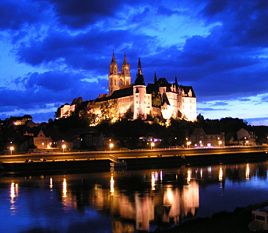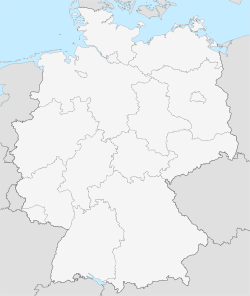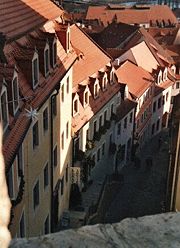Meissen
| Meissen | |
 |
|
| Coat of arms | Location |
 |
 |
| Administration | |
| Country | Germany |
|---|---|
| State | Saxony |
| Admin. region | Dresden |
| District | Meißen |
| Town subdivisions | 12 Stadtteile/Stadtbezirke |
| Mayor | Olaf Raschke |
| Basic statistics | |
| Area | 30.90 km² (11.9 sq mi) |
| Elevation | 106 m (348 ft) |
| Population | 28,544 (29/09/2005) |
| - Density | 924 /km² (2,393 /sq mi) |
| Other information | |
| Time zone | CET/CEST (UTC+1/+2) |
| Licence plate | MEI |
| Postal codes | 01654–01662 |
| Area code | 03521 |
| Website | www.stadt-meissen.de |
Meissen (in German orthography: Meißen; Sorbian: Mišno; Latin: Misena, Misnia, Misnensium) is a town of approximately 30,000 about 25 km (16 mi) northwest of Dresden on both banks of the Elbe river in the Free State of Saxony, in eastern Germany. Meissen is the home of Meissen porcelain, the Albrechtsburg castle, the Gothic Meissen Cathedral and the Meissen Frauenkirche. The Große Kreisstadt is the capital of the Meissen district.


Contents |
History
Meissen is sometimes known as the "cradle of Saxony". The city grew out of the early Slavic settlement of Misni and was founded as a German town by King Henry the Fowler in 929. In 968, the Diocese of Meissen was founded, and Meissen became the episcopal see of a bishop. The Catholic bishopric was suppressed in 1581 after the diocese accepted the Protestant Reformation (1559), but re-created in 1921 with its seat first at Bautzen and now at the Katholische Hofkirche in Dresden.
The Margraviate of Meissen was founded in 968 as well, with the city as the capital of the Margraves of Meissen. A market town by 1000, Meissen passed to the Kingdom of Poland in 1018 under Boleslaw I the Brave, to hands of Emperor Conrad II in 1032 and the House of Wettin in 1089. The city was at the forefront of the Ostsiedlung, or German colonization of the Slavic lands east of the Elbe, and its reception of city rights dates to 1332.
The construction of the Meissen Cathedral was started in 1260 on the same hill as the Albrechtsburg castle. The resulting lack of space led to the cathedral being one of the smallest cathedrals in Europe. The church is also known as being one of the most pure examples of Gothic architecture.
During World War II, a subcamp of Flossenbürg concentration camp was located in Meissen.[1]
Porcelain
Meissen is famous for the manufacture of porcelain, based on extensive local deposits of china clay (kaolin) and potter's clay (potter's earth). Meissen porcelain was the first high quality porcelain to be produced outside of China.
The first European porcelain was manufactured in Meissen in 1710, when the Royal Porcelain Factory was opened in the Albrechtsburg. In 1861, it was moved to the Triebisch river valley of Meissen, where the porcelain factory can still be found today. Along with porcelain, other ceramics are also manufactured.

Main sights
The Albrechtsburg, the former residence of the House of Wettin, is regarded as being the first castle to be used as a royal residence in the German-speaking world. Built between 1472 and 1525, it is a fine example of late Gothic style. It was redecorated in the 19th century with a range of murals depicting Saxon history. Today the castle is a museum which is just as popular with visitors as the cathedral, whose architecture is Gothic and whose chapel is one of the most famous burial places of the Wettin family. Near the castle is Meissen Cathedral (Meißner Dom), built in the 13th century in the Gothic style. The hill on which the castle and the cathedral are built offers a view over the roofs of the old town.
Meissen's historical district is located mostly around the market at the foot of the castle's hill. It contains many buildings of Renaissance architecture. Also imposing is the view from the 57 metre high tower of the Frauenkirche (Church of Our Lady), situated in the old market-place. This church, not to be confused with the Dresden Frauenkirche, was first mentioned in a 1205 deed issued by Bishop Dietrich II and after a blaze about 1450 rebuilt in the Late Gothic style of a hall church. Its tower hosts the world's first porcelain carillon, manufactured in 1929 at the town's 1000-years-jubilee. Another popular tourist sight is the world-famous Meissen porcelain factory.
From spring to autumn, several festivals take place in Meissen, such as the pottery market or the Weinfest, which celebrates the wine harvest. Meissen wine is produced at the vineyards in the river valley (Elbtal) around the town, part of the Saxonian wine region, one of the northernmost in Europe.
Notable residents
- Saint Benno, Bishop of Meissen, born about 1010 in Hildesheim, died June 16, 1106
- Heinrich Frauenlob, poet, born 1250/60, died November 29, 1318 in Mainz
- Johann Klaj, poet, born 1616, died February 16, 1656 in Kitzingen
- Johann Elias Schlegel (1719-1749), critic and poet
- Johann Adolf Schlegel (1721-1793), poet and clergyman
- Samuel Hahnemann (1755-1843), physician
- Karl G. Maeser (1828-1901), Mormon academic
- Ralf Schumann (born 1962), Olympic shooter
Twin towns
 Vitry Sur Seine, France, since 1973
Vitry Sur Seine, France, since 1973
See also
- List of Margraves of Meissen
- Rulers of Saxony
- Saxon Switzerland
Sources and external links
- Municipal website (German)
- Giga-Catholic
- Meissen Porcelain
- History of Meissen Porcelain Works
- Further information on Tourism
- Webcam Meissen (German)
- Backstamp Dating Guide from VintageRareStuff.com
References
- ↑ Christine O'Keefe.Concentration Camps.www.tartanplace.com/tartanhistory/concentrationcamps.html
|
|||||||